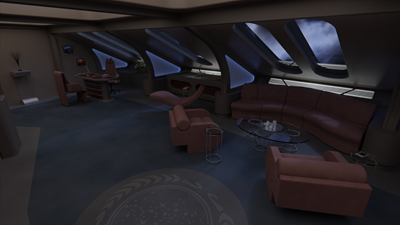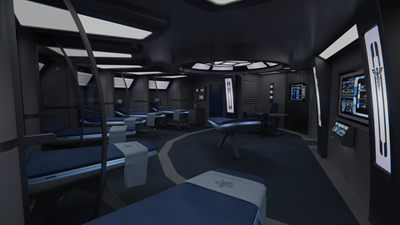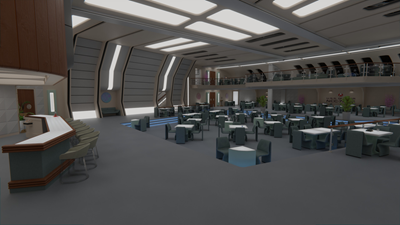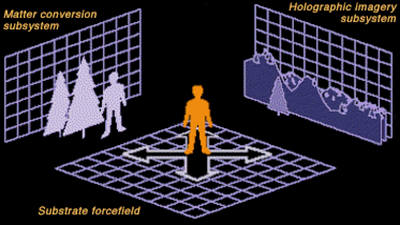Crew Support Systems
Created by Commodore Wilkan Targaryen on Sat Dec 21st, 2024 @ 1:19pm
Crew Quarters
 Aboard Federation Starships the crew are seen as the most important system aboard a starship and this is reflected in the Crew Quarters assigned to personnel aboard the ship. Quarters aboard Starfleet vessels are classified depending upon several variables including their size, arrangement, and occupancy, but all personnel are assigned a minimum of 100 square meters of living space aboard a vessel. Crew Quarters are modular so that new living spaces can be created quickly, but each cabin is normally configured with a bedroom, living/work area, and a small bathroom. Quarters may be shared by multiple crewmembers depending upon the occupant's rank and 10% of the vessel's cabins may be converted to non Class-M environments as needed.
Aboard Federation Starships the crew are seen as the most important system aboard a starship and this is reflected in the Crew Quarters assigned to personnel aboard the ship. Quarters aboard Starfleet vessels are classified depending upon several variables including their size, arrangement, and occupancy, but all personnel are assigned a minimum of 100 square meters of living space aboard a vessel. Crew Quarters are modular so that new living spaces can be created quickly, but each cabin is normally configured with a bedroom, living/work area, and a small bathroom. Quarters may be shared by multiple crewmembers depending upon the occupant's rank and 10% of the vessel's cabins may be converted to non Class-M environments as needed. Presently, the Starship Enterprise maintains several varied crew and guest accommodations aboard the ship.
Crew Quarters Configurations | ||||
| Spartan Quarters | Spartan Quarters are the most basic accommodations that can be installed aboard a Federation Starship and are normally attached to vessels geared more toward tactical assignments than exploration. Instead of individual beds, most spartan cabins include bunk beds, lack comfortable furniture, and are not fitted with Replicators. | 0 | ||
| Basic Quarters | Basic Quarters are smaller cabins that are normally assigned to enlisted or lower ranked officers aboard the Enterprise. Basic cabins are minimally furnished and potentially shared by as many as four people. | 875 | ||
| Expanded Quarters | Expanded Quarters are middle of the road accommodations aboard Starfleet vessels. Larger than basic cabins, Expanded Quarters are slightly more luxurious and are used by a variety of travelers aboard the vessel including families, mid-ranking officers, and the like. | 310 | ||
| Luxury Quarters | Luxury Quarters are the largest, most luxurious cabins aboard the Enterprise. Assigned to the Senior Staff and VIPs, Luxury Quarters are multiple room suites that feature advanced amenities unavailable in smaller cabins. | 85 | ||
| Unusual Quarters | Unusual Quarters are atypical cabins that are designed to accommodate special needs. | 40 | ||
Environmental Systems
Among the most critical systems aboard a Federation Starship, Environmental Systems is a blanket term that covers the vessel's life-support systems, gravitational support, and other related technologies. Essential for the survivability of the Enterprise's crew, without the Environmental Systems the crew would quickly be lost.
Consumables
While the development of the Replicator created a post-scarcity economy, there are still objects that are either extremely difficult or impossible to replicate. To compensate, Federation vessels carry several resources within storage to overcome the deficit of unreplicatable materials. While the Enterprise maintains Replicators, Starfleet Command has arranged for the ship to carry a stockpile of real food aboard the vessel as well as extra supplies, each of which are stored within the Cargobays.
Gravity Systems
 Located throughout the Starship Enterprise, Gravity Generators are disk-shaped devices that are used to create artificial gravity aboard a starship. Located in the flooring tiles of the vessel, the Gravity Generators produce gravitons thanks to an internal suspended superconducting stator that creates the gravitational field. Similar in many ways to a Tractor Beam, the Gravity Generators have internal backups to maintain a gravitational field in the event of a power failure; however, the gravity will degrade in strength so long as the power is unavailable until being lost entirely after approximately five hours.
Located throughout the Starship Enterprise, Gravity Generators are disk-shaped devices that are used to create artificial gravity aboard a starship. Located in the flooring tiles of the vessel, the Gravity Generators produce gravitons thanks to an internal suspended superconducting stator that creates the gravitational field. Similar in many ways to a Tractor Beam, the Gravity Generators have internal backups to maintain a gravitational field in the event of a power failure; however, the gravity will degrade in strength so long as the power is unavailable until being lost entirely after approximately five hours.
Life-Support Systems
 The Primary Life-Support Systems aboard a Federation Starship produce the breathable gases and other environmental support structures that maintain the crew of a vessel. Under Starfleet Regulations all vessels are fitted with an Atmospheric Processing Unit to serve every fifty cubic meters of the habitable space within a spacecraft and feed gases through a network of ventilation ducts. In addition to these functions, Life-Support closely maintains the environmental conditions aboard the vessel to help ensure habitability.
The Primary Life-Support Systems aboard a Federation Starship produce the breathable gases and other environmental support structures that maintain the crew of a vessel. Under Starfleet Regulations all vessels are fitted with an Atmospheric Processing Unit to serve every fifty cubic meters of the habitable space within a spacecraft and feed gases through a network of ventilation ducts. In addition to these functions, Life-Support closely maintains the environmental conditions aboard the vessel to help ensure habitability.Capable of supporting the crew of a vessel for approximately 24 hours, the Reserve Life-Support System is a backup to the Life-Support System. Sharing the same components as the standard Life-Support System, the Reserve system utilizes the same ventilation network to distribute breathable gases. While a capable system, the Reserve Life-Support System functions at half the capabilities of the primary Life-Support System. Should both the primary and reserve systems fail an Emergency Life-Support System is available. This system is comprised of self-contained breathing apparatuses that can maintain a breathable atmosphere for the user for up to an hour, allowing the crewperson to evacuate to a designated emergency shelter.
Due to the risks associated with damage (or sabotage) to the atmospheric systems, access to Life-Support is heavily restricted. Multiple fail-safe redundancies are available to maintain Life-Support while safety locks also help to protect the system from malicious actors. Despite these safeguards, the crew of a Starfleet vessel can choose to alter the operations of the Life-Support Systems depending on mission profile or risk to the ship. Considered an emergency measure, the Environmental Officer of a vessel can cut power to the Life-Support systems and reroute the energy to other systems; however, this procedure may only be implemented in extreme circumstances.
Medical Systems
 Historically, Federation Starships named Enterprise have been cutting edge exploratory vessels that have been on the cutting edge of discovery, including within the Medical field. As a Starship that travels far from the safety of Federation space, the Enterprise has been outfitted with the most advanced Medical Systems currently available within Starfleet and maintains 24-hour availability of all essential specialties, personnel, and equipment.
Historically, Federation Starships named Enterprise have been cutting edge exploratory vessels that have been on the cutting edge of discovery, including within the Medical field. As a Starship that travels far from the safety of Federation space, the Enterprise has been outfitted with the most advanced Medical Systems currently available within Starfleet and maintains 24-hour availability of all essential specialties, personnel, and equipment. The Starship Enterprise maintains two Sickbay Complexes aboard ship that are utilized to preserve the health and well-being of the vessel's crew. Both Sickbays are fully furnished with equipment to safeguard the health of the crew including biobeds with diagnostic monitors, powerful biosensors, workstations, and power generators to maintain Sickbay's Systems in an emergency. If needed the ship's doctors can activate a Surgical Support Frame (a sophisticated tool that helps maintain a sterile field) attached to the biobed to provide support during surgery when a patient cannot be transferred to a dedicated Surgical Bay.
The Primary Sickbay on the Century Class is well equipped to meet the diverse needs of the ship's crew. Upon entry to the Sickbay area the patient will commonly enter through the Clinic, where they can be treated for routine illness or injury. A dedicated Critical Care/Triage Ward serves patients in a true emergency and functions in a similar role to an old Earth Emergency Department. An Intensive Care Ward is available to monitor long-term patients to assist with healing. The remainder of the area maintains Laboratories, Observation Rooms, Offices, Physical Therapy Rooms, Surgical Bays, and Stasis Units that can be used to help treat patients. A Secondary Sickbay in the Engineering Section offers additional treatment options, especially in separated flight modes.
For more information on the Medical capabilities of the Enterprise, please visit: U.S.S. Enterprise Medical Section.
Emergency Medical Holographic Program
 A common service aboard Federation Starships since the late 24th Century, the Emergency Medical Holographic Program (EMH) is a holographic doctor designed to serve as a short-term supplement to the medical team. Incredibly advanced, the EMH can provide a variety of care options to a ship's crew, ranging from routine medical appointments to complex surgery.
A common service aboard Federation Starships since the late 24th Century, the Emergency Medical Holographic Program (EMH) is a holographic doctor designed to serve as a short-term supplement to the medical team. Incredibly advanced, the EMH can provide a variety of care options to a ship's crew, ranging from routine medical appointments to complex surgery. The standard EMH has been designed from the beginning to prioritize healing the sick and injured, with detailed subroutines allowing it to quickly triage patients and offer treatment. The current EMH program contains medical information from throughout the Federation, including over five million known medical treatments within its databases. Despite its advancements, the EMH is not perfect and is traditionally set to "Read Only" mode while in operation. This allows the program to assess an individual and their illness, compare the symptoms to those within its databases, and try programmed treatments. If an illness or injury is outside of its field of expertise the EMH will struggle to resolve the situation.
While an established system on Federation vessels, the EMH requires a network of holoemitters to operate and early EMH programs were confined to the Sickbay only. Onboard the Enterprise the EMH Program can be activated in any area due to the presence of holoemitters on every deck. To assist with its function, the EMH monitors communications within key areas of the ship on the Emergency Medical Channel when active to assist with treating injuries.
Starfleet Medical Regulations restrict access to the Emergency Medical Hologram to true emergency situations in which the medical staff are unavailable. Should a crewmember engage the EMH without authorization they can be reprimanded for their actions as the EMH is, as aforementioned, intended for emergency situations only as extended use can damage the EMH Program and require substantial maintenance. Starfleet Medical has previously worked on the development of the Long-Term Medical Holographic Program; however, thus far, the system has not been approved for use.
Recreation Systems
 Following the challenges experienced by the Romulan Relocation Effort and the First Contact Day Attack on Mars Starfleet and its operations switched from an exploratory orientation to a more defensive and militaristic organization. Surprisingly, Starfleet applied this doctrine to its recreation facilities as well and the lavish, personalized recreation options gave way to more communal options. Following the Borg Invasion during the 250th Frontier Day, Starfleet reevaluated and reorganized its strategies across the board, including a reevaluation of the recreation options for Federation vessels. While Starfleet has not returned its recreation choices luxurious options of the 24th Century, modern starships have more comforts available than their predecessors of the early 25th Century.
Following the challenges experienced by the Romulan Relocation Effort and the First Contact Day Attack on Mars Starfleet and its operations switched from an exploratory orientation to a more defensive and militaristic organization. Surprisingly, Starfleet applied this doctrine to its recreation facilities as well and the lavish, personalized recreation options gave way to more communal options. Following the Borg Invasion during the 250th Frontier Day, Starfleet reevaluated and reorganized its strategies across the board, including a reevaluation of the recreation options for Federation vessels. While Starfleet has not returned its recreation choices luxurious options of the 24th Century, modern starships have more comforts available than their predecessors of the early 25th Century. Descending from the Galaxy and Sovereign Class, the Century Class explorer has a variety of recreational options available to those aboard the ship to help keep the crew mentally and physically active. While the Enterprise is part of a long lineage of Federation Flagships, the recreation options aboard the vessel are somewhat diminished from her predecessors. The Enterprise incorporates large, pleasant dining facilities and several lounges of various sizes for the crew to use. Holodecks and Holosuites are also available for personal recreation options.
For more information on recreation options on the Enterprise, please visit: U.S.S. Enterprise Recreational Facilities.
Holodecks and Holosuites
 Early in its operations, Federation researchers realized that long-term exploratory assignments could impact the mental and physical health of the crew of a starship. Pioneered in the late 23rd Century and revolutionized in the 24th Century, the Holodeck quickly became the cornerstone of Starfleet's recreational acumen aboard its spacecraft.
Early in its operations, Federation researchers realized that long-term exploratory assignments could impact the mental and physical health of the crew of a starship. Pioneered in the late 23rd Century and revolutionized in the 24th Century, the Holodeck quickly became the cornerstone of Starfleet's recreational acumen aboard its spacecraft.The Century Class Starship Enterprise has been equipped with three Holodecks (large holographic environmental simulators) and fifteen Holosuites (smaller, personalized holographic environmental simulators) for the use of the crew. When deactivated the Holodeck appears as a nondescript room, but when active the systems can generate any location or program installed in its databases. This is achieved through the usage of Microminiature Omnidirectional Holodiodes containing the materials needed to generate the complex holographic environment requested. When activated the Holodeck would first generate a three-dimensional, forced perspective background across the horizon and then would use a Matter Conversion Subsystem to create objects within the simulated environment. Finally, the computer would generate life-like interactive characters.
The Holodecks and Holosuites aboard Federation vessels maintain complex computer monitoring and algorithmic calculation to maintain the illusion. As part of its programming, dedicated safety protocols were incorporated into the operational software to protect users from serious injury or death, but these could be deactivated with appropriate command authorization from the Arch. Holding the primary controls of the Holodeck, the Arch allowed the user to issue orders to the simulation to make changes, load a checkpoint, or discontinue. During an emergency the Holodeck was a designated Emergency Environmental Support Shelter and maintained its own power supply separate from the rest of the ship, allowing the crew to be in a peaceful location in their final moments should the situation be untenable.
Personnel Transportation System
 Due to the size of the Century Class walking from one location to the other is often considered to be slow and inefficient. To overcome these deficits related to the size of the ship, Starfleet has created the Turbolift Network to move personnel throughout the ship. The Turbolift Network is a collection of vertical and horizontal turboshafts that move cylindrical Turbolift cars via graviton accelerators throughout the ship at high speeds. Two Turbolift cars are in use by the Enterprise during routine operations. Standard Turbolift cars can travel to any destination on the starship and can be stopped by any crewmember or guest aboard the spacecraft. Their counterpart, the Express Turbolift, are different in operation and can only travel to critical locations aboard the vessel, such as the Bridge, Engineering, Sickbay, and similar locations. Carefully monitored by the Enterprise's Main Computer, sophisticated subroutines ensure that the Turbolift cars do not collide with one another and avoid areas of maintenance during their operations. Each Turbolift car is equipped with internal dampening field technology, similar to that used on the Enterprise as a whole, to help personnel to adapt to the high speeds of travel they're experiencing. This combination of hardware and software ensures that the Turbolift navigates to its destination on the most efficient route possible, allowing a crewperson to travel the entire length of the ship in less than two minutes at high speeds.
Due to the size of the Century Class walking from one location to the other is often considered to be slow and inefficient. To overcome these deficits related to the size of the ship, Starfleet has created the Turbolift Network to move personnel throughout the ship. The Turbolift Network is a collection of vertical and horizontal turboshafts that move cylindrical Turbolift cars via graviton accelerators throughout the ship at high speeds. Two Turbolift cars are in use by the Enterprise during routine operations. Standard Turbolift cars can travel to any destination on the starship and can be stopped by any crewmember or guest aboard the spacecraft. Their counterpart, the Express Turbolift, are different in operation and can only travel to critical locations aboard the vessel, such as the Bridge, Engineering, Sickbay, and similar locations. Carefully monitored by the Enterprise's Main Computer, sophisticated subroutines ensure that the Turbolift cars do not collide with one another and avoid areas of maintenance during their operations. Each Turbolift car is equipped with internal dampening field technology, similar to that used on the Enterprise as a whole, to help personnel to adapt to the high speeds of travel they're experiencing. This combination of hardware and software ensures that the Turbolift navigates to its destination on the most efficient route possible, allowing a crewperson to travel the entire length of the ship in less than two minutes at high speeds. While the Turbolift does offer the ability to quickly traverse the ship, there are crewmembers that prefer to walk to their destination through the vessel's horizontal corridors or vertically through stairwells. Personnel can use the Jeffries Tubes to travel through the ship if necessary as well. Jefferies Tubes - named in honor of Starfleet Captain Matt Jefferies - are access tunnels and utility corridors that form a network throughout the Enterprise. Primarily used by shipbuilders to hide equipment and other technology, Jefferies Tubes can also be used by a crewmember to travel anywhere in the ship.
Categories: Personnel | Operations | Medical